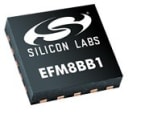8-bit MCUs. It's Cool to be Old School
Follow articleHow do you feel about this article? Help us to provide better content for you.
Thank you! Your feedback has been received.
There was a problem submitting your feedback, please try again later.
What do you think of this article?
There is an old saying: “The right tool for the job”. Large hammer, small nail? Phillips screwdriver, flat head screw? RTOS, toaster oven? You get the idea. In most cases, one could make it work, but more often than not, with unnecessary risk, cost and complexity. Same can be said when selecting an MCU for an application. In this discussion, 8-bit or 32-bit?
32-bit MCU’s are now ubiquitous, and can rival 8-bit devices in terms of size, cost and power. But just because they do, does that mean it’s the right solution?
Considerations:
Code size. These days, most applications are developed using a high level language independent of the architecture. However, code for 32-bit MCU’s is typically larger, requiring more memory hence adding cost to the system as chip designers typically match RAM and Flash size to the anticipated application
Package size. 8-bit devices typically have 8-bit data paths internally and well, 32-bit devices have – you guessed it 32-bit paths. More die space consumed so usually a larger die. What do you do when the die is larger? Use a larger package and that means you can add more features. Most likely all good, but what if you just need a few I/O and a few peripheral connections? Often, an 8-bit device can deliver this optimized solution.
Performance. This is where it gets interesting. 8-bit devices these days are not your old school, “back in the day”, products. Many, like the 8051 core have been optimized to run at speeds up to 100 MHz with on-chip hardware acceleration, prefetch buffers and branch target buffers so can rival low end 32-bit MCU’s. So where an application might need just a bit more performance, but want to keep things simple, an 8-bit solution might just do the trick.
Deterministic Operation: Real time applications require predictability. Feature reach 32-bit devices often have multi-level bus hierarchies, on-chip caches and lots of machine state that can slow response time or make it less deterministic. 8-bit devices on the other hand, can offer faster context switching with less overhead and even adopt “newer” concepts such as register banking to further enhance real time performance.
Tools. This may often be a very compelling factor. While generally simpler, 8-bit MCUs still need to be properly configured, applications developed and tuned. A comprehensive development environment helps to accelerate this development yet must be affordable.
Silicon Labs EFM8 Family:
Silicon Labs recognizes that customers that have a broad set of needs for embedded MCU development and offer both 8- and 32-bit solutions. We continue to develop and enhance our 8-bit EFM8 devices as evidenced by introducing over 100 variations in the last two years that include lower power, enhanced peripherals, capacitive touch and AEC-Q100 qualification, to name a few.
We have four derivitives in our "Bee" Family. First, Why bee? Bee's are one of the most energy efficient insects in the world. Busy Bee is our superset MCU with a large suite of peripherals and package options. Sleepy Bee does what the name suggests - very good for low power applications. Universal Bee provides USB capabilites with the now ubiquitous connectivity standard. And Laser Bee is laser focused where precision, in terms of A/D and D/A applications need both resolution and performance for embedded applications.
These are all supported by our industry leading Simplicity Studio that provides design tools, documentation, software and support…free of charge. Just connect a starter kit and get going!
Click here for the current EFM8 family available from RS



